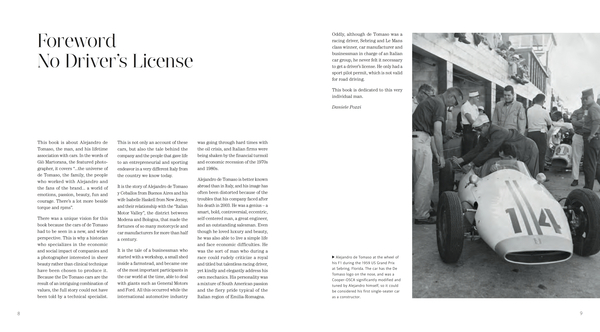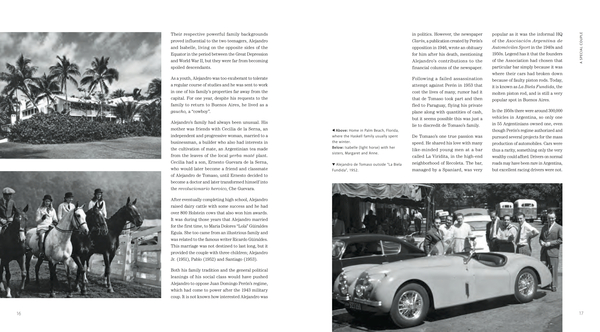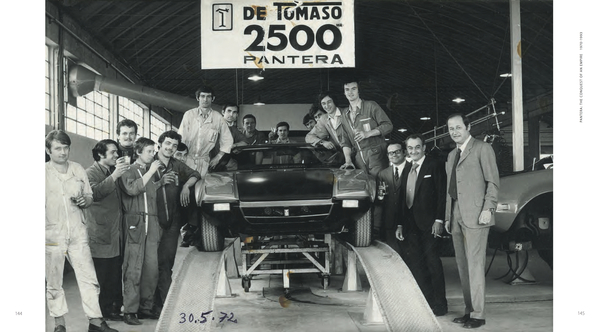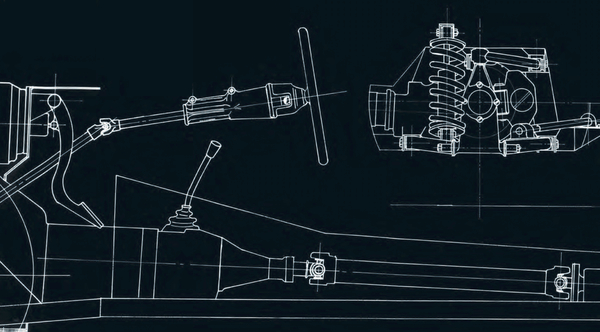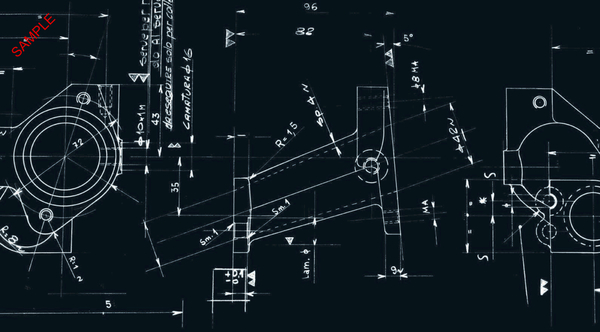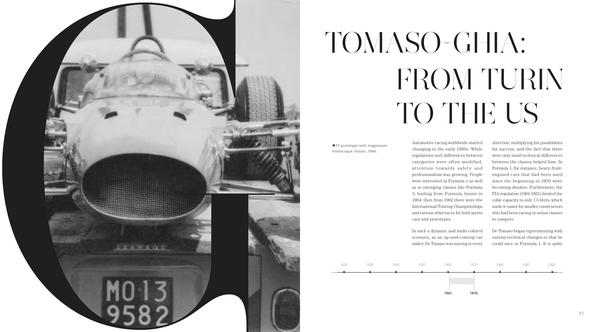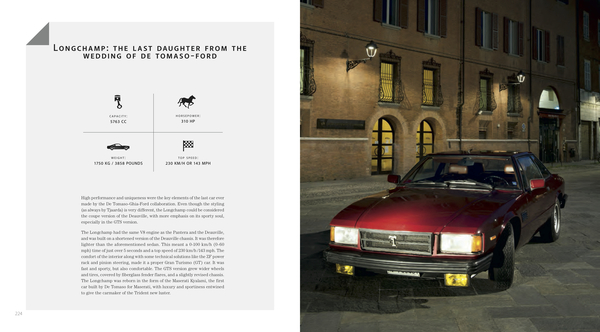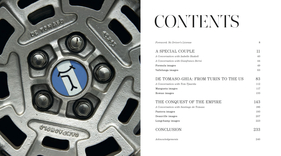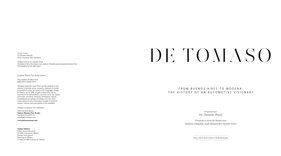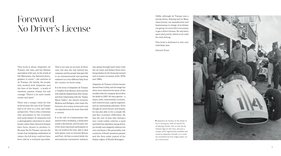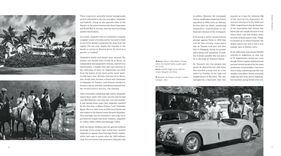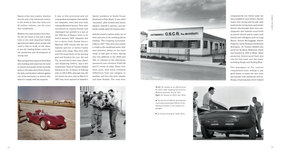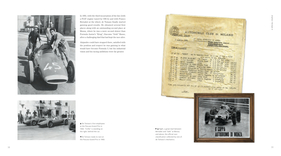In the foreword to this book, the author Daniele Pozzi writes, quoting the photographer Giò Martorana, that Alejandro de Tomaso's story was a world of emotion, dedication, beauty, fun and courage. Accordingly: "There's a lot more beside torque and rpms" (There is much more than just torque and revolutions per minute).
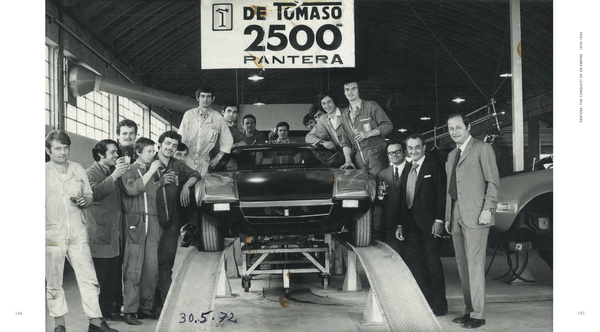
New, broader perspective on De Tomaso
This also resulted in the specifications: "There was a unique vision for this book because the cars of De Tomaso had to be seen in a new, and wider perspective. This is why a historian who specializes in the economic and social impact of companies and a photographer interested in sheer beauty rather than clinical technique have been chosen to produce it. Because the De Tomaso cars are the result of an intriguing combination of values, the full story could not have been told by a technical specialist" (This book was based on a very special idea, as the De Tomaso cars had to be viewed from a new, broader perspective. That is why a historian specializing in company history and a photographer who is only interested in pure beauty and not cold, clinical technology were chosen to produce it. Because the De Tomaso is the result of a fascinating combination of different values, the story could not have been written comprehensively by a technical specialist).
The book therefore includes a classic text section with images in black and white as contemporary documents by Daniele Pozzi and series of newly produced, large-format color photographs by Giò Martorana of all De Tomaso cars, i.e. Vallelunga (Berlinetta and Spider), Mangusta, Rowan City Car, Pantera, Deauville and Longchamp as well as, at the beginning, the Monoposti.
The highlights
The interviews with people who played an important role in Alejandro de Tomaso's life are a particular highlight: Isabelle Haskell, his wife; Gianfranco Berni, the longtime technical collaborator; Tom Tjaarda, the designer of the Pantera and his son Santiago de Tomaso. They are the sources for much of the information contained in the book.

The book consists of four parts:
- The biography of Alejandro de Tomaso and that of his wife Isabelle Haskell up to 1960 and the foundation of De Tomaso Modena S.p.A. in 1959 respectively.
- The years from around 1961-1970, i.e. from the start of building its own racing cars to the production of the Mangusta, including the purchase of Ghia.
- The years from 1971-1993, i.e. the production of the Pantera and the rise and fall of Alejandro de Tomaso's company conglomerate.
- Conclusions with an appreciation of Alejandro de Tomaso's achievements.
The life of Alejandro de Tomaso
Alejandro de Tomaso came from a wealthy Argentinian family and became a works driver for OSCA in 1958. His greatest success was winning the Indice de performance, the displacement-related performance index, in the 24 Hours of Le Mans with Colin Davis on an OSCA Sport 750TN. His American wife, Isabelle Haskell, was also a successful racing driver. As a married couple, they won the performance index of the 12 Hours of Sebring in 1958 in an OSCA 750S. (There is a great picture in the book with the de Tomaso/Haskell duo and the overall winners Phil Hill and Peter Collins at the award ceremony).

Alejandro de Tomaso was considered a man of many ideas. Accordingly, he soon outgrew OSCA and founded his own company in 1959. The company tried its hand at Formula 3 (Formula Junior) and also Formula 1 from 1962 to 1963. It is worth noting that De Tomaso built his own 8-cylinder boxer engine for this, which was designed by Alberto Massimino. This was followed by racing cars, in particular together with Shelby, and other monoposti. In 1970, he built the Formula 1 for the Williams team with the Ford DFV engine.
It soon became clear to Alejandro de Tomaso that resources remained too limited on the basis of entry fees. His role model Ferrari had shown the way with the 250 GT. De Tomaso created the Vallelunga, powered by a Ford Kent engine with a displacement of 1.5 liters, of which 56 were built between 1964 and 1967. Of its successor, the Mangusta, designed by Giorgietto Giugiaro at Ghia, 402 were built between 1967 and 1971. The engine was a Ford Winsor 302 cu.in. with a displacement of 5 liters and approx. 300 hp. For this, he needed additional engineering and production capacities, which he procured with the purchase of Ghia in Turin. Support was provided by the Rowan Controller Company, owned by Isabelle Haskell's brother-in-law. He later developed an electric city car together with Rowan.
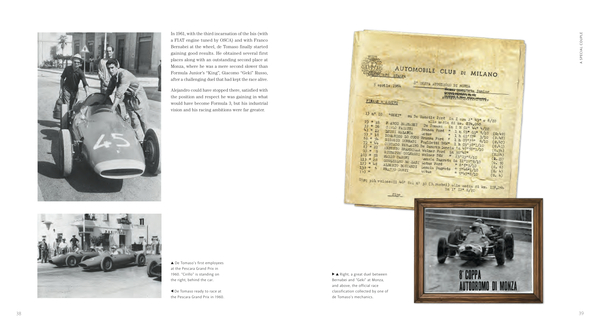
The collaboration with Ford
The collaboration with Ford and in particular the acquaintance with Lee Iacocca then led to the Pantera, which was designed by Tom Tjaarde from Ghia. To create the necessary capacity, Alejandro de Tomaso bought the Vignale company in Grugliasco. Ford acquired a stake in Ghia (and Vignale) and de Tomaso was appointed vice-director of Ford. After the fall of Iacocca, de Tomaso was dismissed from Ghia at the beginning of 1973 and production was stopped in 1975. By this time, around 6,500 cars had been built and sold through Ford's Mercury-Lincoln dealer network in the USA. Production of the Pantera continued in Modena at the parent company De Tomaso Modena S.p.A. until 1991, with unit numbers falling to boutique level. The range was supplemented by the Deauville luxury saloon and the Longchamp coupé.
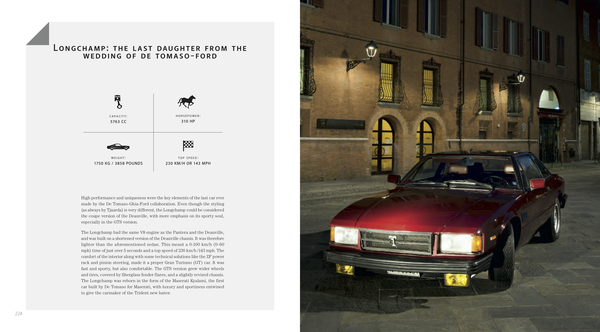
From 1975, Alejandro de Tomaso became a partner of GEPI (Società per le Gestioni e Partecipazioni Industriali), an Italian state-owned finance company for rescuing and restructuring companies in difficulty. This was founded in 1971. As early as 1973, De Tomaso took over the illiquid Callegari & Ghigi from Ravenna and restructured it. He then entered the motorcycle business, first buying Benelli and shortly afterwards MotoGuzzi. Here, too, he launched a restructuring program.
He had made a name for himself as a restructurer and his wealth of ideas seemed inexhaustible. This made him interesting for GEPI. On September 1, 1975, he took over Maserati from GEPI and Innocenti in 1976 with a minimum of his own investment. The introduction of the Maserati Biturbo and Shamal took place during his time. Also the Innocenti Mini from Bertone. In 1984 Chrysler invested in Maserati under Lee Iacocca and between 1979-1981 the Chrysler TC by Maserati was built in (disappointingly) few examples.
The end of the story
From 1988, the trend reversed. Chrysler decided not to increase its stake in Maserati (which had actually been agreed) and in 1989 Fiat joined (and GEPI left). The complete takeover by Fiat took place in 1990.
Benelli was also sold in 1989. Alejandro de Tomaso's empire was once again reduced to De Tomaso Modena S.p.A. in particular, after MotoGuzzi was also finally sold in 1994. This was followed by a final update of the Pantera (SI) and in 1994 De Tomaso presented its last model, the Guarà by Carlo Gaino. It was built until the end of the company in 2004, albeit in very small numbers.
At the beginning of 1993, Alejandro de Tomaso suffered a stroke and had to retire from the management of the company. This is also where the story of Pozzi and Martorana ends. The Guarà is no longer featured in a photo series.
The legacy of Alejandro de Tomaso
The authors see Alejandro de Tomaso's legacy above all in the Pantera and the Pantera effect, i.e. the prominent owners of the car, its use in countless films and its presence in video games. As a businessman, he has won and lost, but his interests have gone far beyond the purely commercial. Her judgment therefore remains indeterminate.

It is this indecision that pervades the entire book. You often ask yourself, what exactly was it like? Without wanting to (and being able to) cast doubt on Pozzi's information, it would probably have been right to disclose the sources. A look at the Internet shows that there are various interpretations of the transactions.
Both in racing and in business, De Tomaso caused quite a stir and the cars were spectacular (and undoubtedly still are today). But in sporting terms, the De Tomasos were not really at the top, despite the respectable successes of individual Panteras. If you take the evil word "added value" as a yardstick, then De Tomaso sold a total of around 8,500 cars (including Ford production). As a partner of GEPI, Alejandro de Tomaso had certainly been able to score points with his ideas where others had long since closed the books, such as the calculation artists at Fiat. The survival of Maserati was thanks to his ideas. But the state funds that were poured into the various activities were only returned to a limited extent.
For lovers of De Tomaso design
What the book offers is an easy-to-read text, many interesting photos and spectacular images of De Tomaso's icons against the backdrop of Modena with the cathedral and the old town. The large format, the generous layout, the use of good paper and the excellent printing make it a quality product.
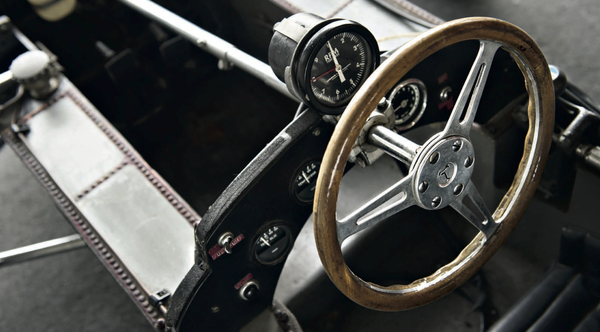
This book is recommended to all lovers of De Tomaso design. Here the cars are shown in their full splendor. Perhaps that really is the greatest compliment that can be paid to Alejandro de Tomaso.
It is published in Italian and English, the English edition being a translation. (N.B: This review is based on the English edition).
The brand remains valuable
After Alejandro de Tomaso retired from the business due to ill health, his son Santiago took over the company and continued to run it until 2004, when bankruptcy proceedings were opened. Liquidation took place in 2012, but the sales results show that the De Tomaso brand still has value. As Zwischengas wrote on March 28, 2015: "According to media reports, a Swiss investor group under the name L3 Holding has bought the rights to the De Tomaso brand for just over two million euros".
In the meantime, however, L3 Holding from Chiasso has had to back out due to financial problems and the Chinese group "Ideal Team Venture" has bought the brand rights for 1.05 million euros.
Bibliographical details
Italian edition:
- Title: De Tomaso: Un argentino nella valle dei motori
- Author(s): Dr. Daniele Pozzi
- Publisher: 24 Ore Cultura
- Edition: 1st edition 2015
- Size/format: hardcover with jacket, 285 x 315 mm, 240 pages, over 200 illustrations
- Language: Italian
- ISBN-13: 978-88-6648-283-3
- Price: at the publisher €45 .00; at amazon approx. €35.00 (each without postage and packaging)
English edition:
- Title: De Tomaso: From Buenos Aires to Modena: The history of an automotive visionary
- Author(s): Dr. Daniele Pozzi
- Publisher: Dalton Watson Fine Books
- Edition: 1st edition 2015
- Size/format: hardcover with jacket, 285 x 315 mm, 240 pages, over 200 illustrations
- Language: English
- ISBN-13: 978-1-85443-278-0
- Price: from the publisher $79 .00; from amazon €45 .00 (excluding postage and packing)



